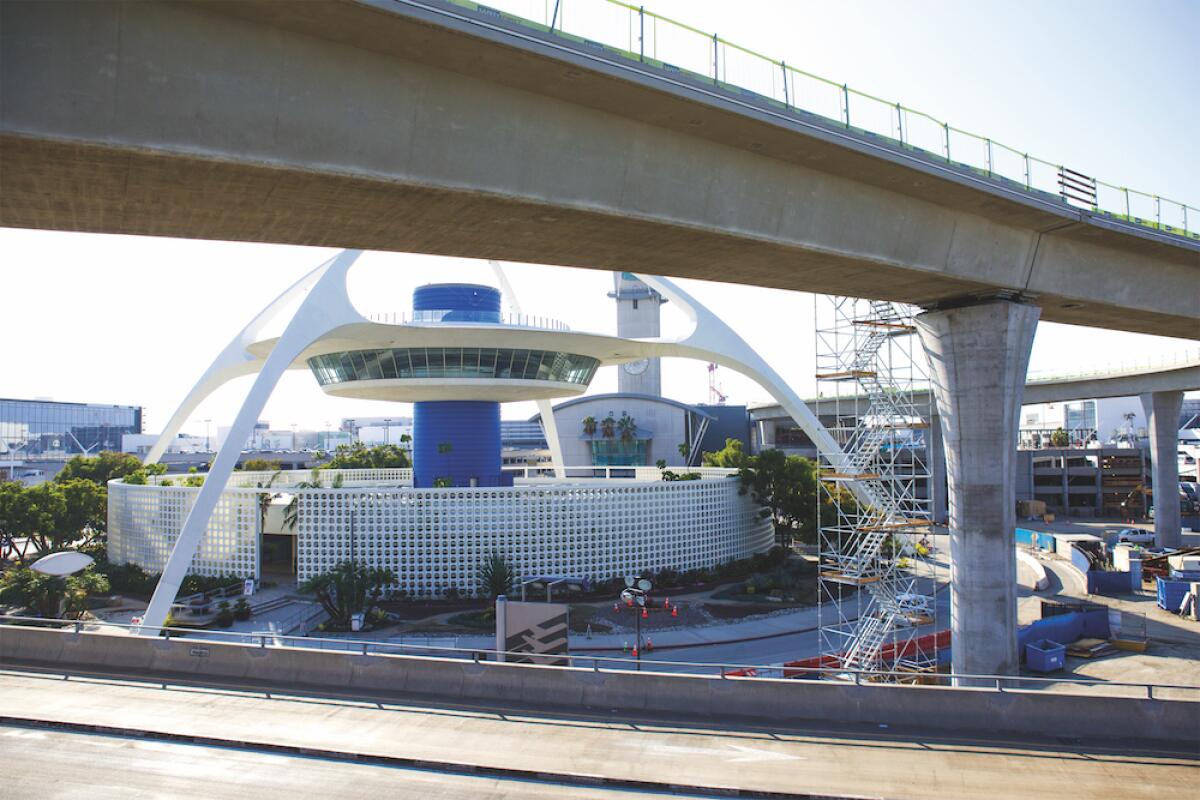Non-Stop Travel: LAX Pickups and Drop-offs Will Run Through Inglewood’s Transit Infrastructure

There’s a running joke in the Southern California region that if you’re picking someone up at Los Angeles International Airport (LAX), they had better be a really good friend. This is an oblique reference to the chaotic “choked horseshoe of doom” pickup and drop-off model that has infuriated travelers there for decades. It’s a real-life video game of private vehicles, taxis, buses, limos and rideshares all jockeying for curbside position, often accompanied by less-than-polite phrasing and gestures.
If you’ve had the dubious pleasure of an LAX run of late, you can’t help but have noticed the massive construction occurring around the airport. While it may not feel like it now, this is in fact the answer to our airport-ride prayers. Because, yes, LAX is finally getting a state-of-the-art people mover system. Combined with a consolidated car rental complex and a connection to L.A. Metro’s new K (Crenshaw) Line, this should radically reinvent the entire LAX experience.
People, Moving
LAX broke ground on its Automated People Mover (APM) project in 2019, spurred at least in part by Los Angeles’ bid for the 2024 Summer Olympics. The city was awarded the 2028 Olympics, but the airport has stuck with its original project completion goal of 2023.
The APM comprises a 2.25-mile elevated guideway with six stations – three inside the LAX terminal area and three outside. During peak hours, it will operate nine four-car trains, with each train capable of carrying 200 passengers. With a top speed of 47 mph, trains will arrive at each station every two minutes during peak periods. Renderings show neat blue trains winding around and above terminals on elevated concrete guideways punctuated by sleek, minimalist stations, currently clad in scaffolding around the terminal areas.
The APM will be free for all users and operate 24/7.
Its trains will have large, wide doors and level boarding, and each car will have 12 seats designated for passengers in need. Dedicated elevators, escalators, and moving sidewalks will further enhance quick, convenient access between terminals and stations, and passengers will be able to view real-time flight information en route.
With an anticipated 30 million passengers each year, it is estimated that the APM will result in 117,000 fewer vehicle miles traveled per day, according to LAX operators Los Angeles World Airports. On top of this enormous environmental impact, the APM itself will also leverage cutting-edge sustainability practices in order to reduce LAX’s carbon footprint. The fleet’s 44 cars will be fully electric, 98% recyclable, and generate a portion of their own power through regenerative braking. The APM’s command center and maintenance facility generates nearly half of its power from solar energy and is designed to be LEED Gold Certified.
Rental Car Consolidation
But the good news for LAX users doesn’t end there. The airport’s Landside Access Modernization Program also includes the Consolidated Rent-A-Car (ConRAC) facility. Conveniently situated adjacent to the nearby 405 freeway, this will gather rental car operations currently scattered across the area surrounding LAX into a single, 6.4-million-square-foot site. This will house over 18,000 rental vehicles from multiple companies, with a car leaving the facility approximately every two seconds during peak activities.
The ConRAC facility will have its own Automated People Mover station, which means those ubiquitous, traffic-choking rental car shuttle buses will no longer be adding to LAX’s navigation challenges. Even smaller car rental operations that choose not to relocate to the new facility will pick up their customers curbside at ConRAC.
A True Rail Connection
While LAX is not directly adjacent to Inglewood, the city will play a major role in its future. LAX’s APM will also connect to the Los Angeles Metro K Line, which is scheduled to debut in November 2022. This 8.5-mile light rail line will connect South L.A. and the South Bay, teeing at the existing E (Expo) and C (Green) lines, and including stations in Downtown Inglewood and at Westchester/Veterans. From there, the Inglewood Transit Connector people mover, planned for 2026, will link the K Line to the city’s sports and entertainment complexes, in anticipation of these hosting 2028 Summer Olympics events.
So, if you find yourself thinking (or yelling), “What are they even working on?” while navigating LAX construction over the next year or so, be assured that it is all for the long-term good. Because none of us are going to miss the airport’s current curbside car combat, which can leave travelers frustrated and weary before they even get near a plane.